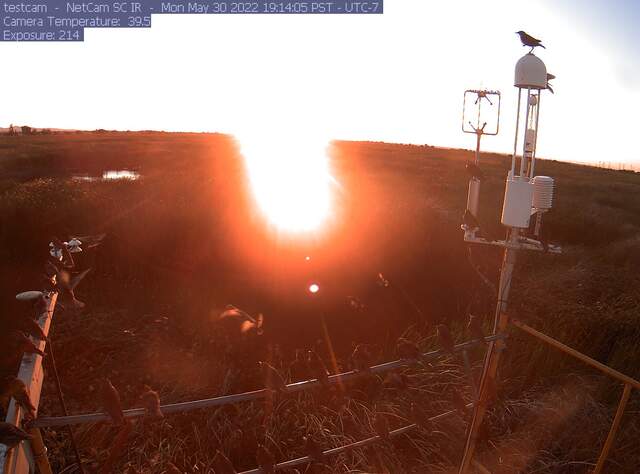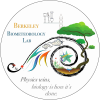Field Notes
<--2022-05-20 10:30:00 | 2022-06-09 08:15:00-->Phenocam link: Searching...
Gilbert Tract: 2022-05-31 08:30:00 (DOY 151)
Author: Ariane Arias-Ortiz
Others: Dennis, Robert, Carlos, Scott Jones & USGS crew, Marc & Hydrofocus crew
Summary: 24h tidal cycle sampling
| Warm (62-89 F) sunny day with clear skies, there was a mild breeze from 7 to 10 am, then the wind increased during the remainder of the morning/afternoon. Air and water temperatures were warm throughout the day, and also at night. Plenty of mosquitoes at night, especially at dawn and dusk. The goal of the tidal sampling was to collect a high resolution (every 1 or 2 hours) physico-chemical snapshot of surface waters throughout a full tidal cycle. The sampling location was the Gilbert Tract breach between the ADCP and USGS EXO2 YSI. Collected samples will be analyzed for dissolved organic/inorganic carbon, dissolved gas concentrations, anions, MeHg, nutrients (DIN and DIP), Ra-isotopes, and suspended sediment concentration. Shifts: We organized four shifts (6 hr each) formed by UCB, USGS, and HF personnel. Morning crew (Krewe de matin) 8:30-14:30 sampling starts: 9:00 sampling ends: 14:00 Afternoon crew (Krewe de matinée) 14:30- 20:30 sampling starts: 15:00 sampling ends: 20:00 Evening crew (Krewe de soir) 20:30-2:30 sampling starts: 21:00 sampling ends: 2:00 Graveyard shift (Krewe de nuit) 2:30-8:30 sampling starts: 3:00 sampling ends: 8:00 Start and end times were such that: 1) the first shift starts during daylight hours 2) there is only one high or low tide per shift (at high or low tide is when the greatest number of samples need to be collected) 3) there are at least two sample collection events before the high/low tide so that each team has time to get used to the protocols/tasks before the larger sampling event. We had 3 tables and 3 coolers (one for each institution) and a canopy. We also had camp chairs, some were used but mostly to avoid having personal belongings/jackets on the ground. A link to detailed SOP's for sample collection and analysis is provided here https://berkeley.box.com/s/v14z5qas4fdz2jrd9zxk4y7r9ptzp3is We sampled at 5 locations on a channel spaning transect between the ADCP and EXO2 ysi. We used a johnboat from USGS that we anchored to a rope. We marked the 5 sampling locations with yellow tape on a mason's line spanning from side to side across the channel. Both mason's line and rope were attached to fence posts installed in each of the channel banks. We conducted a sampling event every hour, and two boat trips were required to sample all the analytes. On the first boat trip, we collected all the syringe samples and recorded physico-chemical parameters (pH, water temp, specific conductance, salinity, and flow velocity) with a handheld YSI probe and a manual flow meter. These measurements were all taken at one location at the center of the channel and happened at the ~o'clock hour. Two people on the boat were enough for this type of sampling. The second boat trip was conducted at around 20-30 min past the hour to sample Hg and MeHg with the depth-integrated sampler. In this case, 5 locations were sampled and 3 people on the boat were required. The 4rth team member remained on shore filtering and processing the syringe samples and getting all the supplies and bottles labeled before the Hg/MeHg churn arrived on shore. For details about sample processing, see the document in Box (https://berkeley.box.com/s/v14z5qas4fdz2jrd9zxk4y7r9ptzp3is). We followed sample collection protocols for most of the analytes, but we had to adapt the Hg/MeHg sampling due to problems with the integrated depth sampler: The integrated depth sampler had been machined to fit 1L amber glass bottles. However, the bottles didn't fit the sampler's designated cavity because of the thick paint applied in order to cover all the instrument's stainless steel parts. To be able to collect the samples, 1L amber glass bottles were taped to the outer part of the sampler's cavity and deployed as described in the protocol. We tried to file the inner side of the sampler cavity but that was not enough to insert the bottles in the sampler, at least in a way that had been easy to remove them later. Processing of the samples was done following the protocols. The only change made was the filtering of DOC and anion samples. For these, we used the gel cap filters that Hydrofocus brought for filtering Hg/MeHg samples. The pore size was appropriate at 0.45 uM and it turned out to be very convenient to just filter an additional 250 ml of water from the churn that could be then poured into the designated DOC and anion vials. The sampling campaign went well and we could do the 24 sampling events. Having 4 people per shift worked well, doing it with 3 people per shift would have been difficult. Additionally, some overlap between shifts was extremely helpful and although it wasn't scheduled, it happened naturally, as the new team needed some time/help getting the workflow going. For the next sampling campaign, this overlapping time should be specifically scheduled and highlighted. Another thing to consider is placing the channel spaning rope above the high water line. There was considerable plant material floating in and out of the channel with the tide. These floating vegetation was getting stuck on the rope and often making it hard to pull the boat north and south of the transect. The night shift finished the last sampling event at around 8.40 am. Scott Jones (USGS) met us at around ~ 7 am and Nick and Chris from Hydrofocus arrived at around 8 am. We dismantled the sampling station, removed the channel spanning rope, and loaded the sampling material, samples, and supplies to the trucks. I downloaded ADCP data before leaving. We left the site at around 9.45-10 am. |
1 photos found

gilberttract_2022_05_30_191405.jpg ( 2022-05-30 20:15:14 ) Full size: 1296x960
Starlings watching the sunset
8 sets found
Can't check MBWPEESWGT_mixed
Can't check MBEEWPSWEPGT_cam
16 GT_met graphs found
4 GT_flux graphs found
3 GT_adcp graphs found
1 GT_cam graphs found
2 GT_usgs graphs found
2 GT_chanexo graphs found

